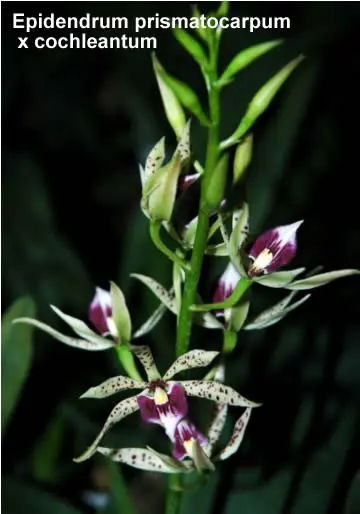 |
||
| Epidendrum A large genus with over 1000 members, it is found in tropical America, from Florida south as far as Argentina. Most of the species grow well in intermediate conditions, with appropriate shading and moisture during growth. They do not require a resting period. |
||
| Epidendrum prismatocarpum x cochleantum | ||
| /\ Top of Page | ||
 |
||
| Epidendrum A large genus with over 1000 members, it is found in tropical America, from Florida south as far as Argentina. Most of the species grow well in intermediate conditions, with appropriate shading and moisture during growth. They do not require a resting period. |
||
| Epidendrum pseudoepidendrum | ||
| /\ Top of Page | ||
 |
||
| Epidendrum A large genus with over 1000 members, it is found in tropical America, from Florida south as far as Argentina. Most of the species grow well in intermediate conditions, with appropriate shading and moisture during growth. They do not require a resting period. |
||
| Epidendrum pseudoepidendrum alba | ||
| /\ Top of Page | ||
 |
||
| Epidendrum A large genus with over 1000 members, it is found in tropical America, from Florida south as far as Argentina. Most of the species grow well in intermediate conditions, with appropriate shading and moisture during growth. They do not require a resting period. |
||
| Epidendrum radicans | ||
| /\ Top of Page | ||
 |
||
| Epidendrum A large genus with over 1000 members, it is found in tropical America, from Florida south as far as Argentina. Most of the species grow well in intermediate conditions, with appropriate shading and moisture during growth. They do not require a resting period. |
||
| Epidendrum stamfordianum alba | ||
| /\ Top of Page | ||
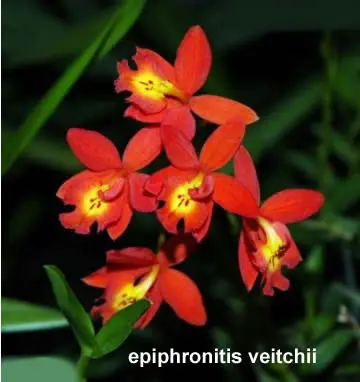 |
||
| Epidendrum A large genus with over 1000 members, it is found in tropical America, from Florida south as far as Argentina. Most of the species grow well in intermediate conditions, with appropriate shading and moisture during growth. They do not require a resting period. |
||
| Epiphronitis veitchii A primary hybrid between epidendrum radicans and sophronitis coccinea. Intermediate growing. This is an almost ever-blooming miniature when fully mature. |
||
| /\ Top of Page | ||
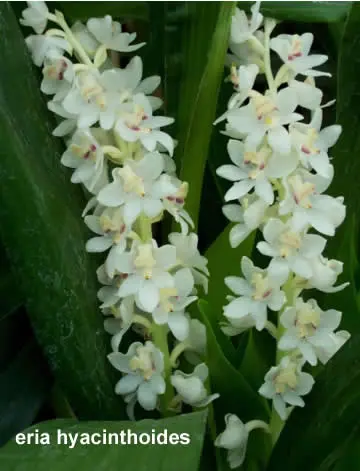 |
||
| Eria
500 or so species make up this genus which is distributed from China to the south Pacific islands. It is related to Dendrobium but many have pseudobulbs instead of canes. Can be mounted on bark or hanging baskets. These plants like a short rest after the growth cycle. |
||
| Eria hyacinthoides | ||
| /\ Top of Page | ||
 |
||
| Eria
500 or so species make up this genus which is distributed from China to the south Pacific islands. It is related to Dendrobium but many have pseudobulbs instead of canes. Can be mounted on bark or hanging baskets. These plants like a short rest after the growth cycle. |
||
| Eria javanica Found from India to the Philippines it produces long (50cm) racemes of white dendrobium style flowers. It has pseudobulbs with two leaves and can bloom more than once a year. Grow in warm conditions |
||
| /\ Top of Page | ||
 |
||
| Eria
500 or so species make up this genus which is distributed from China to the south Pacific islands. It is related to Dendrobium but many have pseudobulbs instead of canes. Can be mounted on bark or hanging baskets. These plants like a short rest after the growth cycle. |
||
| Eria tomentosa | ||
| /\ Top of Page | ||
 |
||
| Eria
500 or so species make up this genus which is distributed from China to the south Pacific islands. It is related to Dendrobium but many have pseudobulbs instead of canes. Can be mounted on bark or hanging baskets. These plants like a short rest after the growth cycle. |
||
| Eria ventricosa | ||
| /\ Top of Page | ||
 |
||
| Eulophia
Some 250 species make up this genus which are distributed throughout the tropics, with most in Africa. These are terrestial orchids that can be found in a wide variety of habitats. |
||
| Eulophia guineensis Probably the most sought-after species from the equatorial regions of Africa, which can be found from Liberia eastwards to Ethiopia and Arabia and southwards as far as Tanzania. It grows in shady places, in the wild, in forests and in relict patches of scrub near rock outcrops or termite mounds. The plants are dormant for at least half the year, but the tall spike emerges with, or just before, the luxuriant leaves. The flowers are large and graceful, each with a large pale pink lip. |
||
| /\ Top of Page | ||
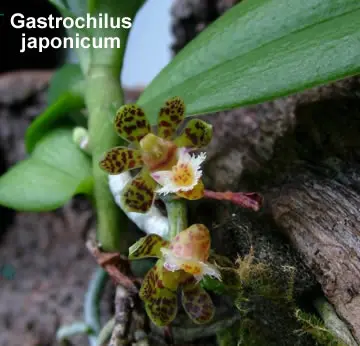 |
||
| Gastrochilus
An Asian genus with around 45 species, it can be found from southern India to the Philippines. The growth is monopodal and intermediate conditions are required, with good light levels. |
||
| Gastrochilus calceolaris | ||
| /\ Top of Page | ||
 |
||
| Gastrochilus
An Asian genus with around 45 species, it can be found from southern India to the Philippines. The growth is monopodal and intermediate conditions are required, with good light levels. |
||
| Gastrochilus japonicum | ||
| /\ Top of Page | ||
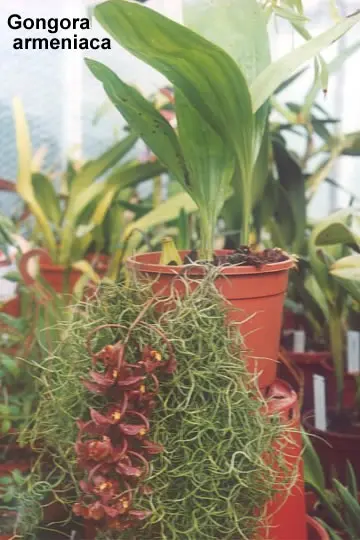 |
||
| Gongora
A south american genus distributed from Mexico down to Bolivia. These plants are ephiphytes with hanging inflorescences and should be cultivated in baskets under intermediate to warm temperatures. Plenty of water and fertiliser is appreciated. |
||
| Gongora armeniaca | ||
| /\ Top of Page | ||
 |
||
| Gongora
A south american genus distributed from Mexico down to Bolivia. These plants are ephiphytes with hanging inflorescences and should be cultivated in baskets under intermediate to warm temperatures. Plenty of water and fertiliser is appreciated. |
||
| Gongora galeata | ||
| /\ Top of Page | ||
 |
||
| Jumellea Around 45 monopodial ephiphytes and lithophytes are distributed in Madagascar and other islands around the indian ocean. The plants are easy to cultivate and can be mounted on bark or planted in baskets or pots. They like planty of water during the growing season, and a dry period after flowering. |
||
| Jumellea sagitata | ||
| /\ Top of Page | ||
 |
||
| Cochleanthes
15 species form this genus, distributed from Costa Rica down to Peru. The plants are epiphytes living in the cloud forest and are quite happy with intermediate conditions. A succession of single flowers means flowering can be all year long. |
||
| Keferanthes sua mena A cross between Cochleanthes amazonica x Kefersteinia graminifolia this plants produces flowers in succession, blooming for most of the year. Keep at intermediate temperature and provide good light. |
||
| /\ Top of Page | ||
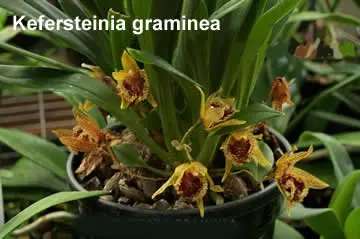 |
||
| Kefersteinia There are 36 species in this genus from south america from Mexico down to Ecuador. With no pseudobulbs they form fan like sheaths from whcih single flowers emerge . The plants are ephiphytes growing in wet forests and should be grown in intermediate conditions, with plenty of water all year. |
||
| Kefersteinia graminea | ||
| /\ Top of Page | ||
 |
||
| Kefersteinia There are 36 species in this genus from south america from Mexico down to Ecuador. With no pseudobulbs they form fan like sheaths from whcih single flowers emerge . The plants are ephiphytes growing in wet forests and should be grown in intermediate conditions, with plenty of water all year. |
||
| Kefersteinia tolimensis | ||
| /\ Top of Page | ||
 |
||
| Laelia
A south american genus, there are around 60 species distributed from Panama to Mexico. Ephiphytes, they grow well on slabs, hanging baskets or pots and should be cultivated under intermediate conditions. |
||
| Laelia purpurata | ||
| /\ Top of Page | ||